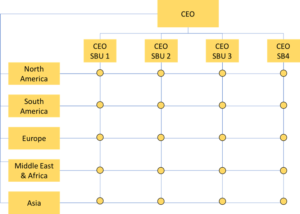
Different Types Of Organizational Structure
By G5global on Thursday, February 13th, 2020 in Bookkeeping. No Comments
The matrix developed as a natural evolution of organizational structures in answer to a very definite real-world need. The need was for an organizational form capable of managing the recent very large and very complex programs, projects, and problems, and for managing limited resources. Implicit in the definition of the matrix organization is the recognition that the project is temporary whereas the functional departments are more permanent. Although all organizations are temporary in that they are constantly changing, the matrix is designed to be temporary and a particular organizational structure lasts only for the finite life of the project.
Relationships between functional and product managers should be explicit so that people are in approximate agreement about who is to do what under various circumstances. Properly used, a matrix does not leave such matters in an indefinite status; it is a definite structure and not a “free form” organization. The matrix organizational form is only desirable if there is a real need for its added complexity.
Advantages Of Matrix Structures
The https://online-accounting.net/matrix-organization-the-advantages-and-the/al form may vary from one in which the project manager holds a very strong managerial position to one in which he plays only a coordinating role. To illustrate the organizational principles, a matrix will be considered first in which there is a balance of power between the project and functional managers. It must be recognized that such a balanced situation, considered by some authorities to be ideal, probably seldom occurs in practice. In balanced matrix organizations, project and functional managers share the authority. The project manager has a full-time role, while project management staff will be part-time.
Use ‘Matrix Organization’ In A Sentence

Galbraith has described the managerial alternatives as a continuum ranging from pure project to functional (figure 10) . The matrix falls in the middle of the continuum, and can range from very weak to very strong depending on the relative balance of power. The project manager in a Matrix Organization has two very important interfaces — with top management and with functional management.
How This Company Used Anthropology To Understand Its Customers
A team is a group of employees—ideally with complementary skills and synergistic efforts—working toward a common goal. Teams are created by grouping employees in a way that generates a variety of expertise and addresses a specific operational component of an organization. These teams can change and adapt to fulfill group and organizational objectives.
Different Types Of Organizational Structure

Fortunately, varied but more complex organizational alternatives have become available. The present management philosophy is that there is no “one best way” for all projects to organize. Rather there are many alternatives from which to select a specific project.
- Such approach allows balancing employees’ time and knowledge between routine tasks and project work.
- The main advantages of this structure are efficiency, strong project focus, easier post-project transition and flexible use of organizational resources.
- The third main type of organizational structure, called the matrix structure, is a hybrid of divisional and functional structure.
- However, a matrix organizational structure has both advantages and disadvantages.
- Employees report to their line manager (also known as functional manager) on their routine tasks and simultaneously report to the project manager on specific project tasks.
However, the business experienced significant decline in sales in that year. This decline was worsened because of the lack of focus on customer experience. When Howard Schultz resumed the CEO position in 2008, he changed Starbucks Coffee’s corporate structure to bring focus back onto customer experience.
In matrix management, the organization is grouped by any two perspectives the company deems most appropriate. Common organizational perspectives include function and product, function Matrix Organization and region, or region and product. In an organization grouped by function and product, for example, each product line will have management that corresponds to each function.
The various managers must be communicating with each other on at least a daily basis, and usually more often. Therefore a more adequate organizational model is shown in figure 7, which shows the managerial relationships as double-ended arrows, indicating that the relationships are two-way streets. Consultation, cooperation, and constant support are particularly necessary on the part of the project and functional managers.
Starbucks’s corporate culture influences how such team effectiveness is achieved. The company’s development depends on team-based factors and associated human resource management strategies. Starbucks Corporation (Starbucks Coffee Company) uses its organizational structure to facilitate business Matrix Organization development in the global coffee industry. As the largest coffeehouse chain in the world, the company maintains its industry leadership partly through the appropriateness of its corporate structure. Starbucks evolves to ensure that its organizational structure matches current business needs.
Power Struggles
A good working relationship with and ready access to top management is essential for resolving big problems and removing obstacles. A good working relationship with functional management will ensure that most problems are resolved at their level and will Matrix Organization not have to go to top management. The conventional matrix model (figure 1) does not adequately emphasize these most important relationships. Obviously, neither the project manager nor the functional managers can sit in their offices and give orders.

When would you use a matrix structure?
A matrix organizational structure is a company structure in which the reporting relationships are set up as a grid, or matrix, rather than in the traditional hierarchy. In other words, employees have dual reporting relationships – generally to both a functional manager and a product manager.
This is simply a variation of the product structure, in which the different business segments at the bottom are each split into a specific customer group – for https://online-accounting.net/ example, inpatients, outpatients and free clinic patients. The managers of each segment would then report directly to the hospital president at the top.
Aqa A Level Business Study Notes: 3.6 – Decision-making To Improve Human Resource Performance

It will only work if the entire organization, from top management to the project personnel, are thoroughly “sold” on the matrix concept. There are many reasons why the matrix will not work, but failure to lay the groundwork and fully prepare the organization is the principle reason for failure. The organizational alternatives have also been described in terms of the percentage of the organizational personnel who are full-time members of the project team . In a functional organization, there is no one on the project team, and in a pure project organization, essentially everybody is on the project team. The matrix falls in between, and includes a variety of organizational alternatives ranging from a weak to a strong matrix.

Leave a Reply